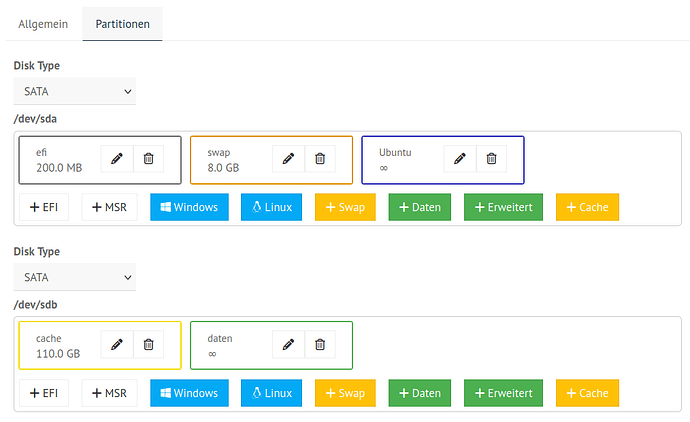Hallo,
ich komme mit linbo eigentlich ganz zu recht. Außer wenn in einem PC mehrere Laufwerke vom gleichen Typ eingebaut sind. In meinem Fall eine SSD (119G) und eine HDD (931G). Beides sind SATA-LW.
Das führt dann dazu, dass mal das eine, mal das andere Laufwerk die Bezeichnungen sda bzw sdb bekommen. Die Label helfen da irgendwie auch nicht so richtig. Beim Formatieren scheint sich linbo nicht an den label zu orientieren, sondern an den Gerätenamen.
Die Partitionierung sieht so aus:
Hier noch die start.conf:
[LINBO]
Server = 10.16.1.1
Group = ubuntu22efi_fujitsu_221
Cache = /dev/sdb1
RootTimeout = 600
AutoPartition = no
AutoFormat = no
AutoInitCache = no
GuiDisabled = no
UseMinimalLayout = no
Locale = de-DE
DownloadType = rsync
SystemType = efi64
KernelOptions = quiet splash nomodeset
clientDetailsVisibleByDefault = yes[Partition]
Dev = /dev/sda1
Label = efi
Size = 200M
Id = ef
FSType = vfat
Bootable = yes[Partition]
Dev = /dev/sda2
Label = swap
Size = 8G
Id = 82
FSType = swap
Bootable = no[Partition]
Dev = /dev/sda3
Label = ubuntu
Size =
Id = 83
FSType = ext4
Bootable = no[Partition]
Bootable = no
FSType = ext4
Id = 83
Size = 110G
Label = cache
Dev = /dev/sdb1[Partition]
Bootable = no
FSType = ntfs
Id = 7
Size =
Label = daten
Dev = /dev/sdb2[OS]
Name = Ubuntu
Version = 22.04.LTS
Description = Ubuntu 20.04
IconName = ubuntu.svg
BaseImage = ubuntu.qcow2
Boot = /dev/sda3
Root = /dev/sda3
Kernel = /boot/vmlinuz
Initrd = /boot/initrd.img
Append = ro splash
StartEnabled = yes
SyncEnabled = yes
NewEnabled = yes
Autostart = no
AutostartTimeout = 5
DefaultAction = start
Hidden = yes
Wenn nun linbo startet und die SSD wird als /dev/sda erkannt, ist alles okay. In diesem Fall zeigt linbo die HDD-Größe der großen Festplatte an und alles funktioniert wunderbar.
Blöd wird’s, wenn stattdessen die HDD als /dev/sda erkannt wird. Nun steht in der linbo-Gui als HDD-Größe die der SSD-Platte und die Probleme beginnen. Versucht man jetzt ein Update / Formatieren vom Cache, gehts schief. Formatiert wird nicht die Partition mit dem label „cache“, sondern /dev/sdb1. Auch ein gesamtes Formatieren führt zu einem ungewollten Partitionsschema mit Betriebssystem auf der HDD und Cache auf der SSD.
Bis jetzt behelfe ich mir damit, dass ich in der linbo-gui immer auf die angezeigte hdd-Größe achte. Dann weiß ich, ob die Reihenfolge passt oder nicht. Wenn nicht, boote ich linbo so oft, bis es passt. Das braucht zwischen 1 und manchmal 10 Versuchen. Das ist dann schon zähes arbeiten.
Ich hoffe ich konnte meine Problematik halbwegs verständlich darlegen. Über Lösungsvorschläge freue ich mich total.
Viele Grüße
Michael
